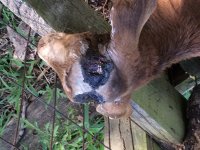DonnaBelle
True BYH Addict
I have my latest copy of Caprine News. In it is a new method of disbudding baby goats. A serum of extract of cloves is injected into the buds at about 5 days of age. There was a trial done, with one side injected, the other not. Very successful trial done. Very interesting. Wouldn't it be wonderful if that would work?
http://www.ncbi.nlm.nih.gov/pubmed/25992247
The link to an article I looked up.
DonnaBelle
http://www.ncbi.nlm.nih.gov/pubmed/25992247
The link to an article I looked up.
DonnaBelle







